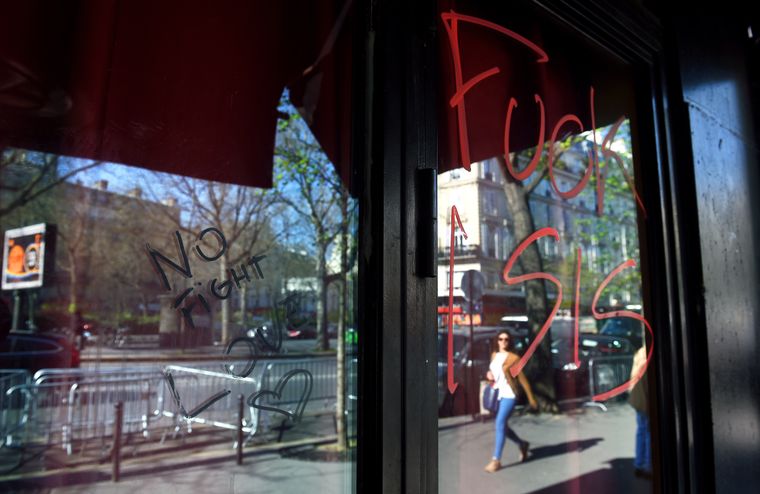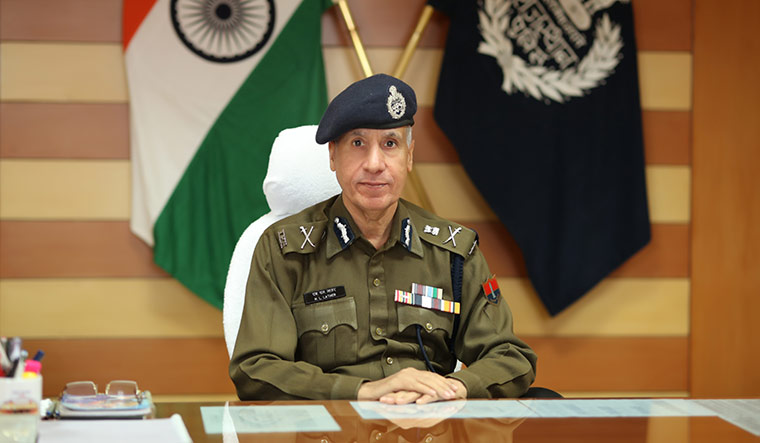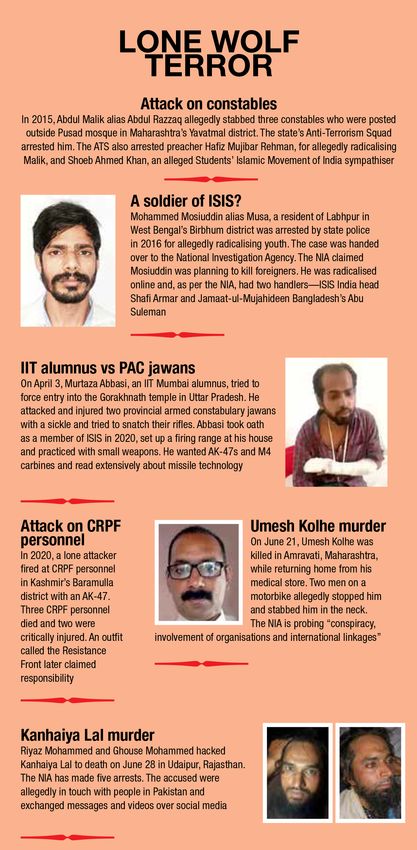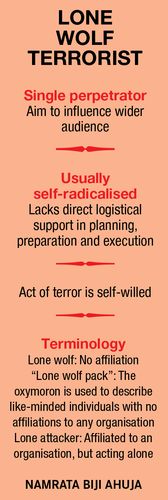Lone wolf terrorism is not a recent phenomenon, but India has largely remained immune to it. At least, until recently. The horrific beheading of tailor Kanhaiya Lal Teli in the tourist town of Udaipur in Rajasthan on June 28 has exposed the cracks in the country’s security and intelligence machinery. Extremist ideologies, propagated by global terror outfits and enabled by the internet and social media platforms, has condensed into a short attack plan that was executed swiftly in Udaipur before any law enforcement agency could respond.
The key accused, Mohammed Riyaz Akhtari and Ghaus Mohammad, were arrested within four hours by the Rajasthan anti-terrorism squad, but the grisly video of the killing, recorded and posted on social media by the fanatics, sent shock waves across the country. The damage was done: curfews, religious tensions, internet shutdowns and fear spread quickly in many parts of Rajasthan and other states.
“We treated the case as an act of terror right from the beginning,” said Ashok Rathore, chief of the Rajasthan ATS and special operations group. Keeping in mind that Ghaus was closely connected with a Karachi-based Islamist organisation called the Dawat-e-Islami, transnational links were investigated, he said. Investigation has shown that Ghaus visited Karachi in 2014. “We arrested four accused (including the two prime accused) and interrogated five people who are to be examined further by the National Investigation Agency,” said Rathore. “We are closely working with the NIA and other agencies,” he said.
NIA officials said the accused, who had conducted a recce of Kanhaiya Lal’s shop, were in touch with several Pakistani numbers over social media platforms like WhatsApp, Skype, Facebook messenger and Snapchat. The digital footprints show a stamp of extremist ideology, posing a major challenge for law enforcement agencies. Even though the initial probe showed that the accused might not be active members of a terrorist organisation in the traditional way, they carry a high degree of ideological attachment and affiliation as lone wolves whose roots cannot be traced to a single source. While creating such hydra-headed monsters quickly is not hard, it is really difficult to eliminate them overnight.
Several lone wolf attacks have been traced back to Islamic State or Al Qaeda ideology like Omar Mateen who carried out a mass shooting at an LGBT nightclub in Orlando, Florida, in 2016 or the 2020 knife attack in Nice, France, in which a woman was beheaded and two others were killed. But India’s geographical proximity with Pakistan and Afghanistan has made it a breeding ground for radicalisation of youth as they become easy targets of extremist literature and propaganda.
The process of self-radicalisation over the internet makes it easy to meet fellow-travellers, giving people like Riyaz and Ghaus entry into a global community of extremists before they finally turn to terrorist activities, according to investigators. “When such self-driven fanatics find an enabling environment or a perceived injustice and are not bound by social and economic obligations, they carry out terror acts like the one witnessed in Udaipur,” said a senior counter terrorism official in New Delhi.
Rajasthan Director General of Police M.L. Lather said while it might be too early to pinpoint the role of a particular terrorist outfit, the fact that Ghaus visited Karachi, the headquarters of the Dawat-e-Islami, between December 2014 and February 2015, raised a red flag. “We have not found any terror links to Dawat-e-Islami. But the accused met different people when he visited Karachi to participate in the activities of the organisation and we are looking into it,’’ said Lather. He said the probe revealed that the accused were radicalised over the internet and social media. “All we can say is that they were in touch with at least a dozen Pakistani numbers. Further investigation will reveal more about their links,” he said.
The Dawat-e-Islami, founded in 1981, is one of Pakistan’s largest Sunni-Barelvi organisations, with common roots on both sides of the border. After its name cropped up during the investigation, Maulana Mahmood Qadri, a senior leader at the Karachi headquarters, said there had not been a single incident where any of their students, followers or teachers were involved in any violent activity. “We are purely an educational, missionary and charity institution and preach peace in our lives,” he told a news agency.
But it has not been a smooth ride for the organisation. It was under scanner in 2011 after the killing of Punjab governor Salman Taseer by his bodyguard Mumtaz Qadri who described the murder as a punishment for blasphemy. The 2020 stabbing outside the French satirical magazine Charlie Hebdo put the organisation under global scrutiny. “Much like the Tehreek-e-Labbaik Pakistan, who are co-Barelvis, they are extremely sensitive to anything perceived even remotely offensive about the Prophet,” said an intelligence official. The Indian wing of the organisation which is also known by the same name has, however, completely dissociated itself from the global organisation. Counter terrorism officials in Mumbai, where the Indian wing has its headquarters, said the ties were completely severed after the 1993 Mumbai bombings which first made New Delhi label Pakistan a sponsor of terrorism.
The Dawat-e-Islami has been running its activities in Kanpur and there is no restriction on the organisation. The Uttar Pradesh ATS, which has joined the multi-agency probe in Udaipur, is examining whether Kanhaiya’s attackers got any logistical aid from Kanpur. The focus, however, is more on online platforms where the faceless and the nameless continue to keep the pot boiling. Uttar Pradesh has been high on the radar of terror groups in the past as a fertile ground for the recruitment of disgruntled youth. The state has witnessed a noticeable change over the years. Police sources said thousands of online posts by radical groups are being detected every day.
Prashant Kumar, additional director general (law and order) in the UP police, said a specialised social media cell was monitoring online activities 24/7 and that no person misusing such platforms would be spared. A senior counter terrorism official said only a thin line existed between “radicalised elements” linked to a particular organisation wilfully executing a terror act and those who were “self-radicalised” and were using different organisations and platforms to remain under the radar of police forces. But in both cases, the outcome is the same—a brutal killing triggered by an event like the Nupur Sharma controversy, with a common goal of spreading terror and panic. The NIA has widened its probe to examine suspected linkages between the Udaipur hacking case and the June 21 killing of a shopkeeper Umesh Kolhe in Amravati in Maharashtra. Kolhe was on his way home after closing his shop when two men on a motorcycle allegedly stabbed him in the neck.
“If a similarity or trend emerges, it may point towards the creation of a new online terror module where self-radicalised individuals carry out brutal killings after online indoctrination and weapons training,” said an officer. Investigators said the need of the hour was not to jump into conclusions and label terrorists under a single brand name. Instead, it is important to bolster the capabilities of intelligence and law enforcement agencies to meet the changing face of terror in the country. “Just like The Resistance Front in Kashmir, which is a conglomerate of operatives from the Lashkar-e-Taiba and the Hizbul Mujahideen, the urban terror outfits, too, have a history of operatives changing names and banners once they come on the radar of national and international counter terrorism organisations,” said former NIA special director N.R. Wasan. He said radicalised boys of the banned Students Islamic Movement of India (SIMI) formed the feeder line when the Indian Mujahideen was born. “What is important is to create conditions to steer the youth away from terror indoctrination,” he said.
The Union home ministry is assisting states to undertake de-radicalisation programmes involving community elders, religious organisations and family members. States like Kerala have already undertaken such measures successfully, while others like UP and Rajasthan are striving hard to follow their lead. “It is an uphill task to identify the radicalised youth before they undertake some action. The challenge also lies in seeing how long can such attempts continue at a stretch,” said Lather.
Mohammed Tahir Madani, director of Jamiatul Falah, the madrasa in Azamgarh in UP from where a number of SIMI leaders emerged, said blaming an entire organisation for the mistakes committed by a few was unfair and could drive a wedge between communities. “To associate any organisation with terror is a big allegation and it must be corroborated first. Secondly, any religious or holy texts are prone to wrong interpretation. But to say that the madrasas are teaching the youth to take law into their own hands sets a negative narrative,’’ said Madani.
It is indeed a tightrope walk for investigators and governments to book the culprits and rope in the community to fight terror indoctrination and extremist ideology. It also requires political will to steer clear of the blame game. Rajasthan Chief Minister Ashok Gehlot, who is facing flak from the BJP for allegedly indulging in appeasement politics, has demanded swift investigation by the NIA into the Udaipur murder.
Ashok K. Behuria, senior fellow at the Manohar Parrikar Institute for Defence Studies and Analyses, New Delhi, said over-interpretation and attempts by the media to find causes at the wrong place could muddy the investigations. Behuria, who has researched extensively on sectarian conflicts in Pakistan, said whether the terror accused in Udaipur were lone wolves or were affiliated to some organisation would become clear once the NIA finished its probe. But before that, the challenge is to thwart online terror activities that have picked up after the murder. “The Udaipur killing is the worst kind of terror act and we all must condemn it,” said Behuria. “At the same time, we should allow investigations to be carried out without jumping into conclusions.”







